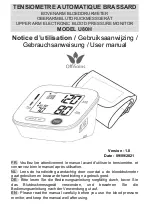
10
95
10
Monitoring FHR and FMP
Using Ultrasound
To monitor a single FHR externally, you use an ultrasound transducer attached to a belt around the
mother's abdomen.The ultrasound transducer directs a low-energy ultrasound beam towards the fetal
heart and detects the reflected signal. Your monitor can also detect fetal movements and print the fetal
movement profile (
FMP
) on the trace. Monitoring using ultrasound is recommended from the 25th
week of gestation for non-stress testing or routine fetal monitoring.
WARNING
Performing ultrasound imaging or Doppler flow measurements together with ultrasound fetal
monitoring may cause false FHR readings, and the trace recording may deteriorate.
Technical Description
Fetal monitors use the ultrasound Doppler method for externally monitoring the fetal heart rate. Using
the Doppler method, the transducer (in transmitter mode) sends sound waves into the body which are
then reflected by different tissues. These reflections (Doppler echoes) are picked up by the transducer
(in listening mode). These Doppler echoes are amplified and sent to the monitor’s speaker through
which the fetal heart signal can be heard. In parallel the Doppler echoes are processed through an
autocorrelation algorithm to determine the fetal heart rate (FHR). The FHR is displayed on the
monitor’s numeric display and on the recorded trace.
Properly representing the fetal heart rate using a device that derives heartbeats from motion is a
formidable task and the limitations of the technology will be discussed shortly. Basic fetal cardiac
physiology may contribute to difficulties in obtaining a reliable ultrasound signal. A heart rate pattern
of a fetus is capable of extraordinary variation, ranging from a quiet stable pattern with minimal
variation while the fetus is “asleep” to robust accelerations of 40-60 bpm above baseline rate over a
few seconds or exaggerated variability when the fetus is active. Decelerations of the rate 60-80 bpm
below baseline may develop even more abruptly than the accelerations. Beat-to-beat arrhythmias may
further exaggerate the amount of “variability” and be seen at the bottom of variable decelerations, or in
the presence of fetal breathing movements which also tend to lower the fetal heart rate. The
recognition of these normal variations in fetal heart rate patterns will greatly assist in the separation of
genuine fetal information from the artifact.
Содержание Avalon FM20
Страница 2: ......
Страница 8: ...8 ...
Страница 56: ...3 Basic Operation 56 ...
Страница 72: ...5 Alarms 72 ...
Страница 82: ...6 Patient Alarms and INOPs 82 ...
Страница 86: ...7 Admitting and Discharging 86 ...
Страница 90: ...8 Non Stress Test Timer 90 ...
Страница 120: ...11 Monitoring Twin FHRs 120 ...
Страница 126: ...12 Monitoring Triple FHRs 126 ...
Страница 136: ...15 Monitoring Uterine Activity Internally 136 ...
Страница 142: ...16 Monitoring FHR Using DECG 142 Testing DECG Mode Refer to the monitor s Service Guide ...
Страница 154: ...18 Monitoring SpO2 154 ...
Страница 164: ...20 Printing the ECG Waveform 164 ...
Страница 166: ...21 Paper Save Mode for Maternal Measurements 166 ...
Страница 170: ...22 Recovering Data 170 ...
Страница 174: ...23 Care and Cleaning 174 ...
Страница 188: ...25 Accessories and Supplies 188 ...
Страница 216: ...26 Specifications and Standards Compliance 216 ...
Страница 221: ...Part Number 453564290161 Printed in Germany 08 11 453564290161 ...
















































